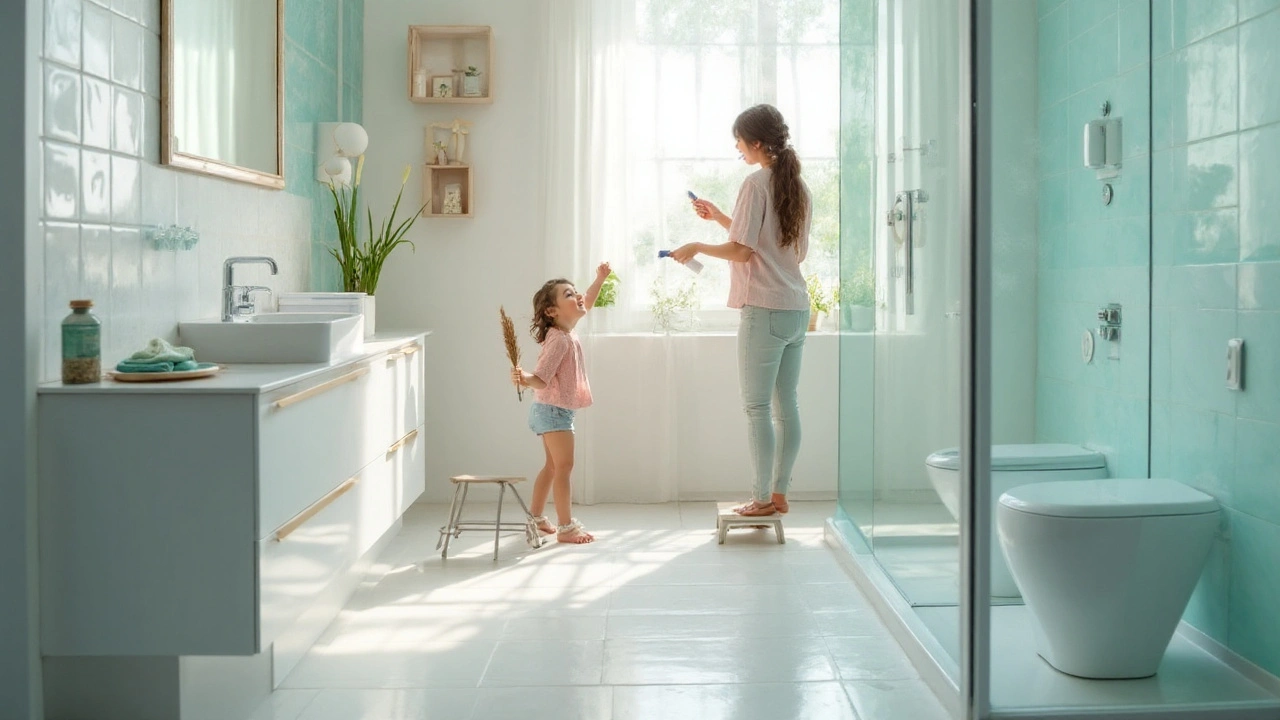Home Hygiene is a collection of daily habits that lower the chance of viruses and bacteria moving between family members. When a fever pops up, the household becomes a hotbed for germs unless you lock down the spread at the source. Below you’ll find a step‑by‑step playbook that works for anyone-from a single‑parent apartment to a busy family home.
Quick Takeaways
- Wash hands with soap for 20seconds; sanitizer only when water isn’t handy.
- Disinfect high‑touch surfaces at least twice daily with EPA‑approved products.
- Cover coughs with a tissue or elbow and toss the tissue right away.
- Wash bedding and clothing in hot water (≥60°C/140°F) after a fever case.
- Boost ventilation by opening windows or using a fan for 15minutes each hour.
Understanding Fever and Its Role in Transmission
Fever is a physiological response that often signals infection, raising body temperature to hinder microbial growth. While fever itself isn’t contagious, the viruses or bacteria causing it are. In a typical household, a single sick child can release thousands of viral particles per sneeze, turning doorknobs, remote controls, and even shared towels into vectors. Recognizing fever as a symptom-not the spreader-shifts the focus to hygiene actions that break the chain.
Core Pillars of Home Hygiene
The CDC groups effective home‑based infection control into seven pillars. Each pillar builds on the others, creating a layered defense that dramatically cuts transmission odds.
- Hand Hygiene
- Surface Disinfection
- Respiratory Etiquette
- Laundry Practices
- Air Quality & Ventilation
- Symptom Monitoring
- Isolation Practices
Hand Hygiene Deep Dive
Hand Hygiene is a routine of washing or sanitizing hands to remove pathogens before they can be transferred to the face or surfaces. The CDC reports that proper hand washing reduces respiratory illness by up to 21% in households.
Key steps:
- Wet hands with clean, running water (temperature doesn’t matter).
- Apply enough liquid soap to cover all surfaces.
- Scrub for at least 20seconds-think “Happy Birthday” twice.
- Rinse thoroughly and dry with a single‑use towel.
If soap isn’t available, use an alcohol‑based hand sanitizer containing ≥60% ethanol or isopropanol. Remember: sanitizer doesn’t cut through greasy dirt, so wash with soap first when hands are visibly soiled.
| Method | Efficacy (log reduction) | Time Required | Skin Impact |
|---|---|---|---|
| Soap & Water | ~2-3 log | 20seconds + rinse | Gentle, moisturizing |
| Alcohol Sanitizer (≥60%) | ~2 log | 15seconds dry | Can dry skin; add moisturizer |
Surface Cleaning and Disinfection
Surface Disinfection is a process that applies chemical agents to kill or inactivate pathogens on hard, non‑porous surfaces. High‑touch spots-doorknobs, light switches, fridge handles-should be wiped with an EPA‑registered disinfectant at least twice daily during a fever episode.
Choose products with proven activity against influenza, RSV, and the common cold viruses. Look for the EPA label claim “Effective against Enveloped Viruses”. For families preferring greener options, a 1:1 solution of hydrogen peroxide and water works on most surfaces without leaving residues.
Respiratory Etiquette and Mask Use
Respiratory Etiquette is a set of habits-covering coughs, sneezes, and speaking-to limit droplet spread. Teach every household member to:
- Cover mouth and nose with a tissue or the inside of the elbow.
- Dispose of tissues immediately into a lined trash bin.
- Wash hands after each cough or sneeze.
If someone is actively coughing, a simple cloth mask reduces the distance droplets travel by up to 60%. Ensure masks are washed daily in hot water.

Laundry and Fabric Care
Laundry Practices are procedures for washing clothing, bedding, and towels at temperatures that inactivate viruses. The CDC advises laundering infected items on the hottest cycle the fabric can tolerate (≥60°C/140°F) and drying them completely.
Tips for busy families:
- Separate visibly soiled items from the rest of the load.
- Add a cup of white vinegar to the rinse cycle for extra disinfection.
- Use a high‑efficiency dryer for at least 30minutes.
Air Quality & Ventilation
HVAC Ventilation refers to the movement of outdoor air into indoor spaces, diluting airborne contaminants. Simple actions dramatically lower aerosol concentration:
- Open windows for 5-10minutes each hour, especially in high‑traffic rooms.
- Run bathroom and kitchen exhaust fans while cooking or showering.
- If you have a portable HEPA filter, place it in the bedroom of the sick individual.
Maintain your HVAC system by replacing filters every 3months; a MERV‑13 filter captures particles down to 0.3µm, which includes most virus‑laden droplets.
Monitoring Symptoms and Isolation Practices
Symptom Monitoring is the daily check of temperature, cough, and other signs that indicate a possible infection. Keep a printable chart near the fridge and record each person’s temperature twice a day. If a fever exceeds 38°C (100.4°F) for more than 24hours, move the patient to a separate bedroom.
Isolation Practices involve limiting contact between sick individuals and others, as well as designating specific items for the ill person. Adopt these rules:
- Use a dedicated bathroom if possible; otherwise, clean it after each use.
- Designate a “sick‑person” set of dishes, utensils, and towels.
- Avoid shared meals; deliver food on a tray and discard the tray after use.
Implementing a Home Hygiene Routine
Combine the pillars into a daily checklist that becomes second nature:
- Morning: Hand wash after bathroom use, wipe high‑touch surfaces with disinfectant, open windows for ventilation.
- Midday: Check temperatures, replace tissues, clean shared utensils after lunch.
- Evening: Hand wash before dinner, disinfect kitchen counters, run the dishwasher on a hot cycle, launder all used fabrics.
- Before Bed: Record symptom chart, close bedroom door, turn on HEPA filter for 30minutes.
Stick to the schedule for at least 48hours after the fever subsides to ensure hidden virus particles are gone.
Common Pitfalls & How to Fix Them
Even vigilant families slip up. Here’s what to watch for:
- Skipping hand washing after coughing: Place a small hand‑soap dispenser near every couch or TV area.
- Using the same cloth for multiple surfaces: Keep color‑coded microfiber cloths-blue for bathrooms, green for kitchen, red for high‑touch areas.
- Neglecting ventilation in winter: Use a heat‑recovery ventilator (HRV) that pulls fresh air without losing heat.
- Storing dirty laundry in the bedroom: Transfer it directly to the laundry basket before it sits in the room.
Resources & Guidelines
CDC Guidelines are government‑issued recommendations that summarize the best evidence for preventing illness spread at home. They stress regular hand washing, surface disinfection, and isolation of symptomatic individuals. Keep a printed copy in your kitchen drawer for quick reference.
Other reputable sources include the World Health Organization’s “Home Care for Respiratory Illness” fact sheet and the American Cleaning Institute’s list of EPA‑registered disinfectants.

Frequently Asked Questions
How long should I keep a sick family member isolated?
Isolation should continue until the fever is gone for at least 24hours without medication and any cough or sore throat has improved. Most experts recommend a minimum of 48hours after symptoms subside to be safe.
Is a home‑made bleach solution as effective as store‑bought disinfectants?
Yes, a solution of 5% sodium hypochlorite (1 part bleach to 9 parts water) kills most viruses within 1minute. Make it fresh daily and label the bottle clearly.
Can I use a regular household vacuum to remove airborne viruses?
A standard vacuum without a HEPA filter will not capture viruses effectively. If you have a HEPA‑rated model, run it on low speed for 15minutes in each room to reduce aerosol load.
What temperature is needed to kill the flu virus in laundry?
Washing at 60°C (140°F) for at least 10minutes reliably inactivates influenza virus. If fabric care limits temperature, add a disinfectant laundry additive.
Do I need to wear a mask at home if I’m the only one with a fever?
Wearing a simple cloth mask while interacting with others reduces droplet spread by up to 60%. It’s a low‑effort, high‑impact measure, especially in the first 48hours of illness.
